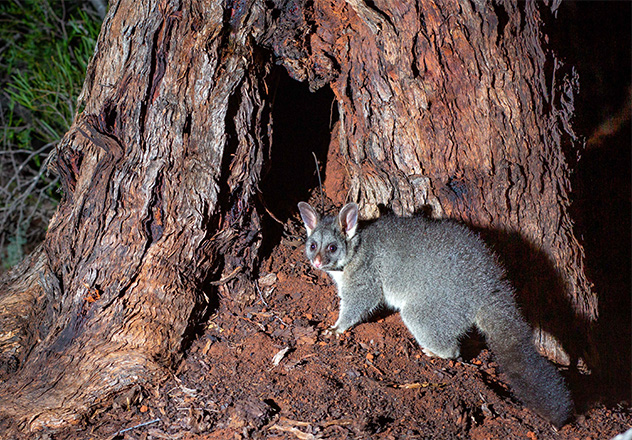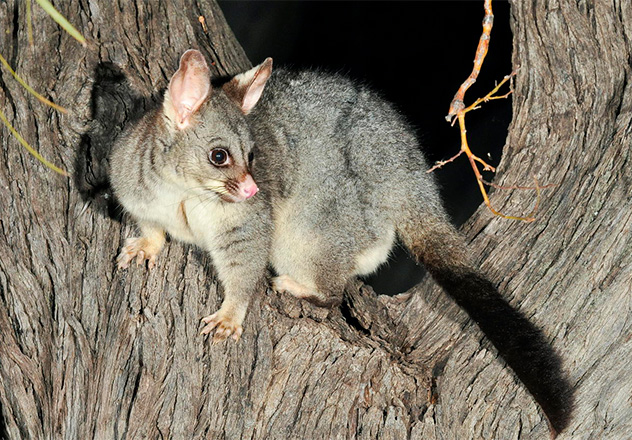Common Brushtail Possums are one of the most abundant, widely distributed and frequently encountered of all Australian marsupials. They are found in many types of habitats and have adapted well to living with humans, commonly encountered in urban areas, suburban backyards, campgrounds and sometimes in the ceilings of houses. Common Brushtail Possum are generally silver-grey with a pale grey to white underbelly, but there is considerable variation in colour and size across their range.

 Brad Leue/AWC
Brad Leue/AWC
In regions where Common Brushtail Possum are rare, AWC protects them at its sanctuaries and partnership areas by implementing fire management (prescribed burning), controlling or eradicating feral herbivores, and working to decrease the impact of feral cats and foxes through baiting and trapping.
During 2021 and 2022 more than 100 individuals were translocated between Karakamia and Mt Gibson Wildlife Sanctuary on the northern edge of the Western Australian Wheatbelt after being absent from that region since the 20th century. Twenty-three of those individuals made history as the first locally extinct species to be released outside the sanctuary’s 7,800-hectare feral predator-free fenced area. The release followed an intensive, ongoing baiting and monitoring program targeting feral cats, which was implemented to give the possums the best chance at survival outside the fence.
At Yookamurra Wildlife Sanctuary in the northern Murraylands of South Australia, AWC protects a significant population of Common Brushtail Possums within the 1,100-hectare feral predator-free fenced area have been the source for reintroductions to the Flinders Ranges in South Australia.
 Wayne Lawler/AWC
Wayne Lawler/AWC
Habitat fragmentation, coupled with the loss of tree hollows for shelter sites, are considered to be threats facing populations of Common Brushtail Possums. This can also lead to competition for resources, both by feral species, as well as displaced possums from nearby territories.
Increased frequency of large intense fires are believed to have caused a decline in populations in central Australia, as well as in northern Australia. The fires are devastating to established hollows, as well as food sources. Predation by a combination of foxes, dogs and cats is another threat they face across their range.

Description
The largest of Australia’s Possums, you can recognise a Common Brushtail Possums by its bushy prehensile tail, which can grow to 40cm in length. They have large, pointed ears, with a dark muzzle and can grow to a length between 32–58cm. Males are often larger than females, growing up to 4.5kg, and usually have rufous fur on the shoulders.
Generally silver-grey above, with a white to pale grey below, there can be considerable variation in colour and size across its range. Those in Queensland have shorter hair and more orange-copper colouring compared to those in Tasmania, which are darker in colour and woollier. Both sexes have a scent gland on their chest which they use to mark their territory with secretions. This gland can stain the fur on the chest deep red.
There are six subspecies recognised across Australia:
Ecology
Like all Possums Common Brushtails are nocturnal, spending the day in a den in a hollow dead branch, tree-trunk, fallen log, rock cavity, burrow of other species or even a hollow termite mound. They are usually solitary, marking their territory with scent secretions or urine, and communicate with other possums vocally, often about territorial disputes, through varied calls of deep chest coughing sounds and high-pitched hissing noises.
They forage in the canopy, in lower levels of the forest, and on the ground and feed on leaves, shoots, and flowers, supplemented with clovers, seeds, and fruits. They will also sometimes consume insects, bugs, worms, caterpillars and grubs, as well as bird’s eggs scavenged from nests. In urban areas, they will eat a variety of foods including scavenging through rubbish for fruit, bread, and pastries.
Breeding can occur at any time of the year if conditions are favourable, but tends to peak in spring, from September to November, and again in some areas during autumn. Mating is polygynandrous, in which both males and females have multiple mates during the season. A single young, only 1.5 cm long and weighing just 2 g, is born 16–18 days after copulation and will remain with the mother until it is about 8 to 10 months old. The first four to five months are spent in a well-developed pouch, attached to one of two teats.
At about seven months old the joey becomes too large for the mother’s pouch and changes its diet from milk to mainly leaves, flowers, and fruit. It is at this time the joey will either go foraging with the mother, riding on her back, or is left in the safety of the den while the mother looks for food. At the age of 10–12 months the young have the knowledge and skills to leave the mother and go off and claim their own territory.
Range and abundance
The Brushtail Possum is known to occupy a variety of habitats from forest and woodlands that provide sufficient trees with hollows, to ground refuges such as hollow logs. They can be found throughout the mainland, as well as Tasmania and offshore islands such as Barrow Island in Western Australia and Kangaroo Island in South Australia. However, this species has disappeared from more than 50% of its former range after European settlement, including vast areas of central and northern Australia.
Habitats vary greatly throughout their range. In the northwest, they prefer Eucalyptus forests and mangroves. In southern Australia however, they also reside in wooded areas, but are sometimes found living a semi-terrestrial life where they den in rock crevasses and termite mounds. In Tasmania, Trichosurus vulpecula can be found throughout the rainforests and dry woodlands.
Help protect the Common Brushtail Possum
Donate nowAWC is developing a targeted survey program for threatened species like the Kowari on NAPCo properties in remote Queensland.
AWC’s Charnley River-Artesian Range Wildlife Sanctuary protects a vitally important population of the Golden-backed Tree-rat.
AWC successfully reintroduced Shark Bay Bandicoots/Western Barred Bandicoots to Faure Island in 2005.